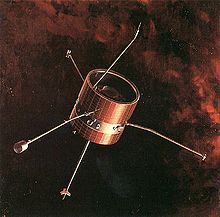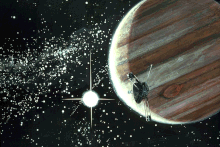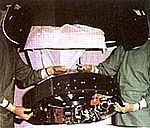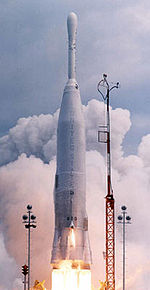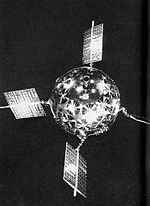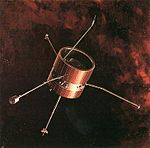Pioneer (space probe program)
Under the name Pioneer ( German pioneer ) a total of 19 different space probes of NASA are summarized, which were launched in the years 1958 to 1978 for the exploration of the moon , the sun , the Jupiter , the Saturn and the Venus .
mission
All Pioneer missions were based on the motto of basic research. Science was initially in second place, more important was the testing of the technology, as space travel was still in its infancy in 1958 .
Pioneer 0 to 4 as well as X, Y and Z had the moon as a target, Pioneer 5 was an interplanetary test flight, Pioneer 6–9 and E were used to explore the sun, Pioneer 10 and Pioneer 11 to advance into the outer solar system (to the giant planet Jupiter and Saturn), Pioneer-Venus 1 and 2 flew to Venus.
course
The US Air Force made the start : It had constructed three 38 kg probes. The aim was initially to overcome the earth's gravitational field and shoot a space probe into orbit around the moon. This was planned without a "stopover" in an earth orbit , as was practiced in later missions. All probes were equipped with optical systems.
- Pioneer 0 together with the Thor Able rocket exploded after 77 seconds on August 17, 1958.
- Pioneer 1 took off on October 11, 1958, due to the premature shutdown of the second stage of the Thor-Able, it only reached a summit height of 113,854 km (about a third of the distance between Earth and Moon) and burned up in the earth's atmosphere after 43 hours of flight.
- Due to the failure of the third stage of the Thor Able launcher on November 8, 1958, Pioneer 2 only reached a distance of 1,500 km and then burned up in the earth's atmosphere.
The next probes were launched by the US Army. Wernher von Braun was one of the scientists involved . The two probes that had been constructed under his supervision weighed only six kilograms and carried a radiation detector as a scientific experiment.
- Due to a premature shutdown of the first stage of the Juno II launcher on December 6, 1958, Pioneer 3 only reached a peak altitude of 102,230 km and, similar to Pioneer 1, burned up after 38 hours of flight in the earth's atmosphere.
- Pioneer 4 on a Juno II rocket achieved a breakthrough for the USA on March 4, 1959: the moon was passed at a distance of 60,000 km. The probe then left the sphere of action of the earth's gravity and was the first US spacecraft to penetrate interplanetary space. Since then, it has orbited the sun. Nevertheless, the USA was too late: Lunik 1 had already carried out the same mission on January 4, 1959, two months earlier.
In order to catch up with the Soviet Union , the new space agency NASA prepared the launch of four lunar orbiters in 1959, each weighing around 170 kg. All four missions were failures and were kept secret from the public. Hence the contradicting names.
- Pioneer P-1 , is also often not listed because the Atlas Able rocket exploded during engine tests on September 24, 1959 before take-off without the payload on board.
- Pioneer P-3 , was destroyed on November 26, 1959 45 seconds after launch by the failure of the Atlas Able missile's payload fairing. The space probe equipped with a television camera was supposed to swing into a lunar orbit.
- Pioneer P-30 , exploded with the Atlas Able launcher on September 25, 1960.
- Pioneer P-31 exploded along with the Atlas Able missile on December 15, 1960.
In 1960, NASA also tested a prototype for an interplanetary spacecraft. Although only one single - 43 kg heavy - was available for this, everything worked:
- Pioneer 5 launched on March 11, 1960 in a Thor Able rocket for a heliocentric orbit between Venus and Earth. Regular contact with the probe could only be maintained until April 30, 1960, after which signals were only received sporadically until June 24, 1960; nevertheless the mission was considered a success.
Then there was a break with the “Pioneers” as part of the Ranger moon probes and the Mariner program (Venus and Mars ). The program was not restarted until 1965. The goal here was the interplanetary space in which a network of probes for solar exploration was to be set up.
- Pioneer 6 launched on December 16, 1965 with a Delta rocket.
- Pioneer 7 launched on August 17, 1966 with a Delta rocket.
- Pioneer 8 launched on December 13, 1967 with a Delta rocket.
- Pioneer 9 launched on November 8, 1968 with a Delta rocket
- Pioneer E launched on August 27, 1969, but the Delta rocket exploded shortly after launch and the probe was destroyed.
The other probes, however, worked satisfactorily. The experiments included measurements of dust particles, various rays and magnetic fields . The Pioneer 7 probe was also used in 1986 to observe Halley's Comet from a distance of 12 million km.
NASA was the first to lose contact with Pioneer 9 on May 18, 1983. The other three probes worked until the mid-1990s. Contact with Pioneer 7 was broken on March 31, 1995, and with Pioneer 8 on August 22, 1996. Communication with Pioneer 6 was also partially interrupted after 1995. One last contact with Pioneer 6 was established on December 8, 2000 - 35 years after its launch. This was an all-time high in terms of service life until Voyager 2 outperformed it on August 13, 2012 .
The last four Pioneer probes were launched in the 1970s. Pioneer 10 and 11 had as a goal the exploration of the planets Jupiter and Saturn , as well as the asteroid belt ; Pioneer Venus of the planet Venus . These missions were successful.
- Pioneer 10 was launched on 3 March 1972, an Atlas - Centaur rocket.
- Pioneer 11 launched on April 6, 1973 with an Atlas Centaur rocket.
- Pioneer Venus 1 launched on May 20, 1978 with an Atlas Centaur rocket.
- Pioneer Venus 2 launched on August 8, 1978 with an Atlas Centaur rocket.
List of Pioneer missions
| Name of the probe | alternative name | image | Start date UTC | Launcher | Starting weight in kg | Mission goal | Result | Rating |
|---|---|---|---|---|---|---|---|---|
| 1958 | ||||||||
| Pioneer 0 | 17th August 1958 | Thor DM-18 Able | 38.1 | Moon orbiter | The launcher exploded 77 seconds after takeoff due to a defective fuel supply. | Failure | ||
| Pioneer 1 | October 11, 1958 | Thor DM-18 Able | 34.2 | Lunar orbiter | Since the launch vehicle's engines switched off too early, the probe only reached a summit height of 113,000 kilometers and later burned up in the earth's atmosphere. | Failure | ||
| Pioneer 2 | November 8, 1958 | Thor DM-18 Able | 39.2 | Lunar orbiter | Since the third stage of the launcher did not ignite, the probe only reached a summit height of 1,550 kilometers and later burned up in the earth's atmosphere. | Failure | ||
| Pioneer 3 | December 6, 1958 | Juno II | 5.87 | Fly by the moon | Since the launch vehicle's engines switched off too early, the probe only reached a summit height of 102,360 kilometers. Before it burned up in the earth's atmosphere, the Van Allen Belt was measured as an alternative when it fell back . | Failure | ||
| 1959 | ||||||||
| Pioneer 4 | March 3, 1959 | Juno II | 6.1 | Fly by the moon | First US spacecraft that could overcome Earth's gravitational field . It passed the moon at a distance of 60,000 kilometers, but a distance of less than 30,000 kilometers was planned, which would have triggered the camera thanks to a light sensor. | Partial success | ||
| Pioneer P-1 | September 24, 1959 (launch vehicle explosion) | Atlas-C Able | 168.7 | Originally a flyby of Venus, finally lunar orbiter | This mission is often not mentioned at all, as the launch vehicle in question exploded during a test before the probe was touched down. In order to start them anyway, the mission "Pioneer P-3" was created. | Failure | ||
| Pioneer P-3 | Pioneer X | November 26, 1959 | Atlas-D Able | 168.7 | Lunar orbiter | The probe was destroyed 44 seconds after takeoff when its plexiglass payload fairing burst. | Failure | |
| 1960 | ||||||||
| Pioneer 5 | Pioneer P-2 | March 11, 1960 | Thor DM-18 Able IV | 43 | Solar orbiter | Originally, this probe was supposed to be used for the first flyby of Venus , but while one struggled with technical difficulties, the launch window closed . As an alternative, a solar orbit between Earth and Venus was targeted to explore interplanetary space . | success | |
| Pioneer P-30 | Pioneer Y | September 25, 1960 | Atlas-D Able | 175.5 | Lunar orbiter | Because of the failure of the additional stage of the launcher, the probe crashed into the Indian Ocean. | Failure | |
| Pioneer P-31 | Pioneer Z | December 15, 1960 | Atlas-D Able | 175.0 | Lunar orbiter | The launcher exploded 73 seconds after takeoff. | Failure | |
| 1965-1969 | ||||||||
| Pioneer 6 | Pioneer A | December 16, 1965 | Delta E | 146 | Solar orbiter for studying space weather | Reached orbit between Venus and Earth. | success | |
| Pioneer 7 | Pioneer B | 17th August 1966 | Delta E | 138 | Solar orbiter for studying space weather | Reached orbit between Mars and Earth. | success | |
| Pioneer 8 | Pioneer C | December 13, 1967 | Delta E | 146 | Solar orbiter for studying space weather | Reached orbit between Mars and Earth. | success | |
| Pioneer 9 | Pioneer D | November 8, 1968 | Delta E | 147 | Solar orbiter for studying space weather | Reached orbit. | success | |
| Pioneer E. | Pioneer 10 | August 27, 1969 | Delta L | 148 | Solar orbiter for studying space weather | The probe crashed into the Atlantic because the launcher's hydraulics failed. It was identical in construction to the four previous probes and would have been named "Pioneer 10" if the mission had been successful. | Failure | |
| 1972-1973 | ||||||||
| Pioneer 10 | Pioneer F. | March 3, 1972 | Atlas SLV-3C Centaur-D | 258 | "Penetration" of the asteroid belt and exploration of Jupiter | The probe passed the asteroid belt unscathed in February 1973 and reached Jupiter in December of the same year. Last contact January 23, 2003. Data has been received for over 30 years. | success | |
| Pioneer 11 | Pioneer G. | April 6, 1973 | Atlas SLV-3C Centaur-D1A | 259 | Investigation of the planets Jupiter and Saturn | The passage at Jupiter took place in December 1974, that of Saturn in September 1979 | success | |
| 1978 | ||||||||
| Pioneer Venus 1st | Pioneer Venus Orbiter | May 20, 1978 | Atlas Centaur | 517 | Venus orbiter for mapping the planet | Submitted data from Venus orbit from December 4, 1978 to October 1992 | success | |
| Pioneer Venus 2 | Pioneer Venus Probe Bus | August 8, 1978 | Atlas Centaur | 904 (380 + 300 + 75 + 75 + 75) | Deposition of a large 1 and three small 2 daughter probes to investigate the Venusian atmosphere. | Although the daughter probes had no landing mechanism whatsoever, one of the small devices, contrary to expectations, survived the impact on Venus by 67 minutes. | success | |
Remarks
Popular culture reception
- Star Trek V: At the Edge of the Universe : A Pioneer probe is viewed by a Klingon as space junk and used for target practice. This could be Pioneer 10 or Pioneer 11 .
See also
Web links
- safog.com: Pioneer Anomaly documentation and diagrams
- Bernd Leitenberger: The Pioneer Program
- extrasolar-planets.com: Pioneer probes
- NASA: Pioneer (English)
- NASA images
Individual evidence
- ^ Press release from NASA from August 20, 2012
- ↑ Pioneer Missions in the NSSDCA Master Catalog , accessed December 8, 2016.
- ↑ Gunter's Space Page: Pioneer P-1, P-3, P-30, P-31 by Gunter Dirk Krebs
- ↑ The Pioneer lunar orbiters: a forgotten failure by Andrew J. LePage of December 13, 2010
- ↑ Drew ex machina Vintage Micro: The First Interplanetary Probe by Andrew LePage, 2014
- ^ Mark Wolverton: The Depths of Space: The Story of the Pioneer Planetary Probes . National Academies Press, 2004, pp. 34 .





